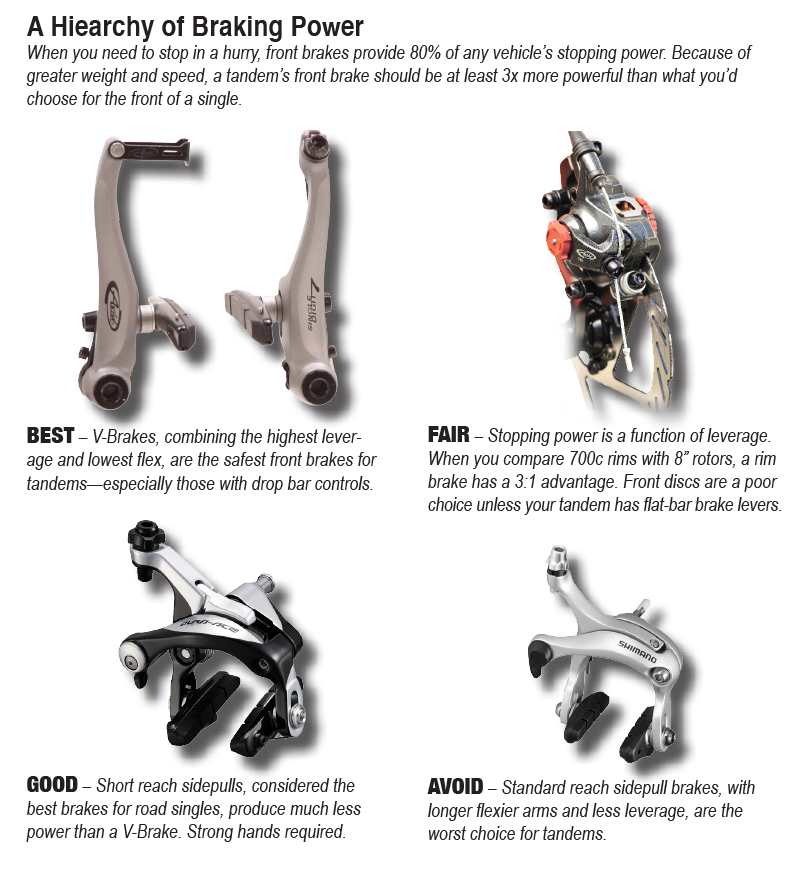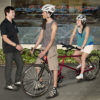

Generation 4 Disc Brake
Two things led Santana to create the industry’s only 10″ disc rotor and the only rotor and caliper specifically designed for tandems:
1. The demise of the drum brake left riders who like a drag brake looking for a modern solution. No rim brake or existing disc brake could handle sustained dragging down a mountain.
2. With the V-brake as the benchmark for power, using existing 7″ or 8″ rotors on a 700c wheel resulted in LESS brake torque for a given lever effort.
We found a brake caliper that used metal rather than plastic bushings and high grade springs to withstand extreme heat, then modified it with a quicker action and stronger return spring to handle the extra cable length of a tandem. We developed a 10″ disc rotor to increase brake torque, absorb more heat, and shed heat faster. 3 generations of rotors saw slightly changing spoke and hole designs to reduce warping, run quieter, and resist lateral flex. Our new 4th Generation rotor represents a giant leap forward in these criteria and drops 90 grams! Two piece button construction with aluminum spider and cooling fins and new cutout patern means quieter operation, no rattle over rough roads, more consistent feel on long descents, and longer pad life. Available only on the rear and recommended for riders who do sustained, steep descents or like to drag their rear brake to control speed on moderate descents. Also for riders who want to run up to a 42mm tire or fender.
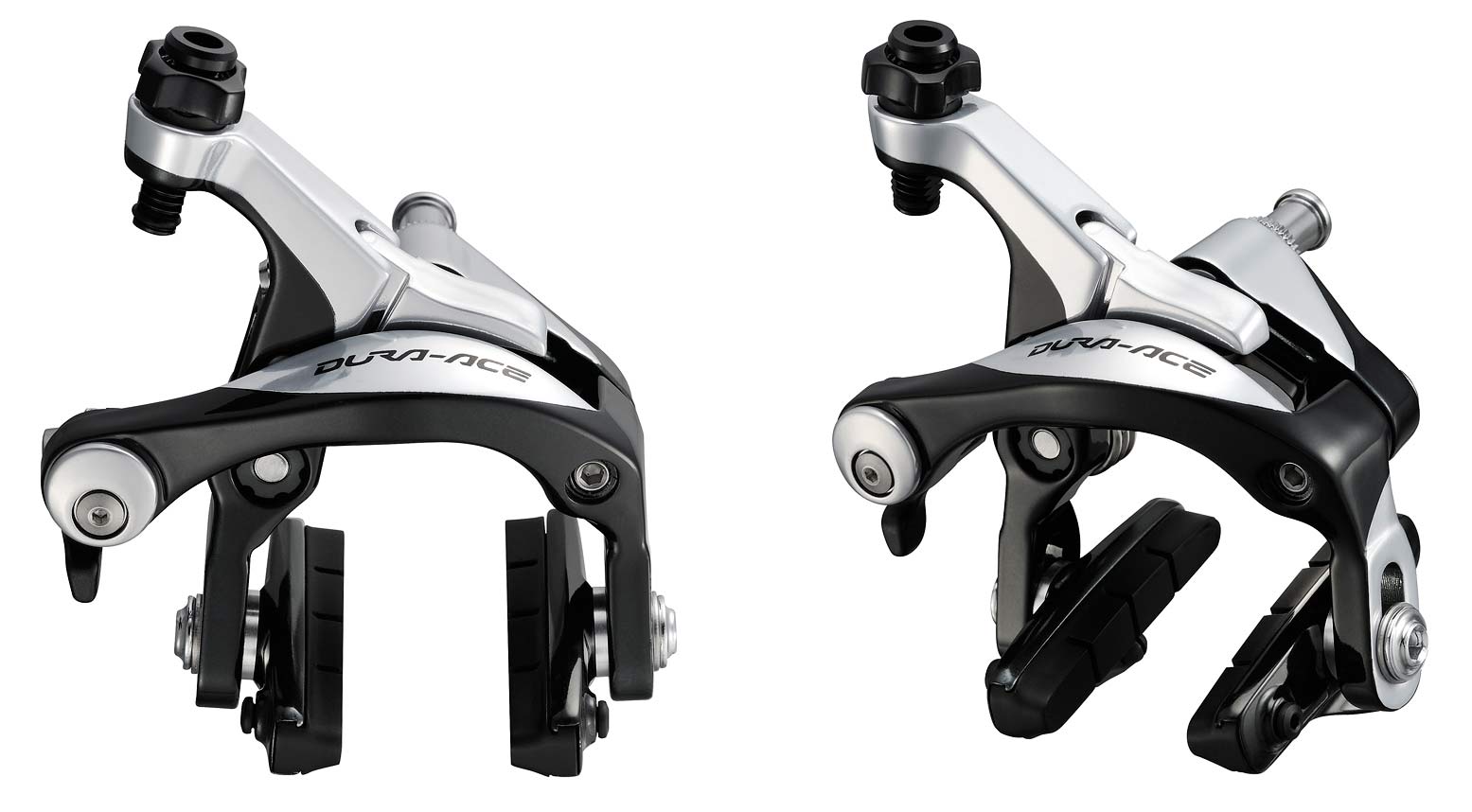
Shimano Road Caliper
Available in Dura-ace or Ultegra levels for front and rear the classic road bike brake caliper is the lightest, simplest solution and the newest generation boasts tandem capable power nearly on par with a V-brake. Boasting easy setup with generous pad-to-rim clearance caliper brakes require the least amount of attention to keep them centered and working their best. Santana paid careful attention to the design of our frames and fork so that you can mount up to a 32mm Continental Gatorskin tire with road caliper brakes which is the biggest most people will want for pavement use. This brake is recommended in the front for riders who prize low weight, less adjusting, and traditional looks over the slight extra power and greater tire clearance of a V-brake. In the rear we recommend a road caliper for riders who’s terrain or braking technique don’t demand the heat capacity of a disc and don’t plan to mount a fender or dirt tire. How much lighter is a twin road caliper setup vs a front V-brake and rear disc? About a pound and a half.

V-Brake
Available on the front of all our bikes and on the rear of the Arriva, Nuovo Sport, Spirit, and Sovereign models the linear pull or V-brake creates a tremendous amount of braking torque relative to lever effort and has plenty of clearance for fenders or the largest tires you can fit through the frame or fork (usually 42mm with knobs). Riders choose this front brake when they need all the clamping force they can get or plan to venture onto gravel roads and want to mount up suitable tires and they don’t mind an occasional centering adjustment to keep them working their best. In the rear a V-brake is a more economical alternative to a disc when you need more tire clearance and braking power than a road caliper offers but you don’t need the massive heat capacity of a disc for dragging down long descents.

POWER vs. HEAT
Some will undoubtedly wonder why Santana supplies road tandems with rear disc brakes. The answer is simple. Santana pioneered the use of disc brakes on lightweight bikes in 1976, and has remained a leading advocate of disc brakes on tandems because of heat. While rim brakes are more powerful, braking occurs as energy is converted into heat. Because of doubled weight and decreased wind resistance, a descending tandem will need to convert over three times more force into heat. On single bikes, rims can get hot. On descending tandems, tripled heat blows tires off rims. If you plan to ride in the mountains, and your team weight exceeds 350, a non-rim brake prevents predictable blow-offs. Further, one non-rim brake is all that’s needed. Unlike a motorcycle, the safest and most effective place to mount the less powerful brake is at the rear, where braking power is four times less critical than at the front.
Exceeding the Melting Point
Finally, in the interest of safety, we feel compelled to pass along the following. Santana tests brakes on a 15 percent grade that’s two-thirds of a mile long. The vertical drop is 528 feet. At the bottom of this short test course the temperature of a disc brake caliper exceeds 500°F. (On a single the heat rise would be one third as great.) Two problems: First, this temperature melts plastic. Avid disc callipers with their red plastic fittings become paperweights after the disfigured adjusters render them unserviceable. Second, because cured carbon bicycle parts are destroyed if subjected to heat greater than 225°F, mounting a tandem’s disc caliper to a carbon fork or frame is, ahem, not recommended.
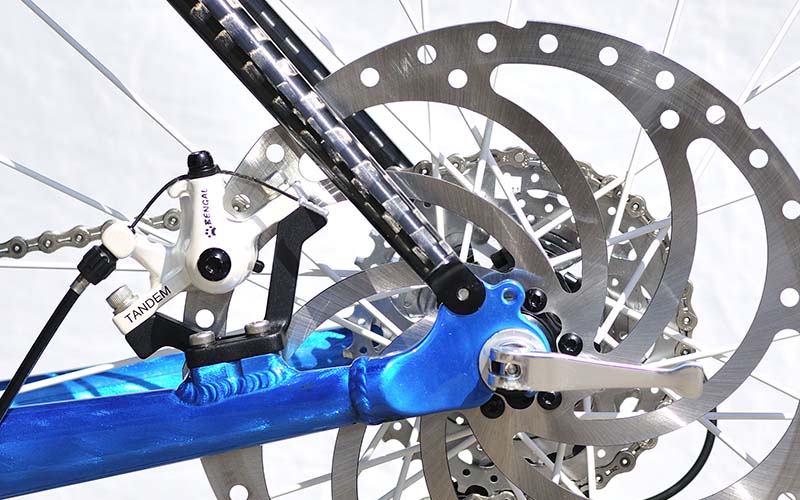
SANTANA’S NEW DISC BRAKE
While the best rim brakes are powerful, lightweight and easy to operate, when a heavy tandem descends a steep grade the resulting heat build-up (up to four times that of a single bike) can blow-out a tire. Heat capacity, not stopping power, is why 20th-century tandems employed a drum brake. Unfortunately, because these simple “drag” brakes provided minimal stopping power, they couldn’t safely replace either rim brake. Consequently, decades of argument ensued as to the best way to operate three brakes. Lacking three arms, and never satisfied with the status quo, at Santana we dreamed of a lightweight disc powerful enough to replace a rim brake.

MECHANICAL vs. HYDRAULIC
Until now, the most powerful tandem disc brakes came with hydraulic fluid—a messy choice for enthusiasts who demand simplicity. Previous mechanical discs, however, were inherently inefficient. Specifically, mechanical designs from Hayes, Avid, Formula, Hope and Shimano produced braking through the asymmetric movement of a single brake pad. With these unbalanced designs significant braking will not occur until the advancing pad warps the disc up against the opposing fixed pad. Compared to the hydraulic discs from the same companies (where opposing pads apply equal pressure) the result was diminished braking power, uneven pad wear and poor modulation. While primitive mechanical discs were adequate for single bikes, even the strongest captains couldn’t squeeze a brake lever hard enough to skid the rear wheel of a loaded tandem.
A PATENTED EFFICIENCY
At an international trade show Santana discovered a young company with a breakthrough design—the first bicycle disc with mechanical ball bearing actuation and balanced power. Since early 2004 we have assisted this small company—named Winzip—with development and testing. In the meantime, they received a patent for a mechanical disc with two powered pads.
A TANDEM-SPECIFIC DESIGN
Although Winzip has been delivering brakes for the past two years, their earliest calipers had a number of small problems. In short, their inspired design wasn’t yet good enough. The tandem version that Santana has helped to create has stronger internals, smoother ramping with additional bearings, advanced pads and improved lever response. Moreover, to keep things simple, our special version requires far less maintenance. Finally, Winzip’s new Tandem model (manufactured exclusively for Santana) doesn’t have any plastic pieces that can melt and fail. Spare parts? While Santana’s tandem specific brake comes with premium long-life pads, standard Shimano pads fit and work great, and can be purchased anywhere.
BIGGER IS BETTER
While others have matched the 8-inch dimension Santana pioneered six years ago, we moved on to develop larger and more capable systems. What’s so special about Santana’s big 10-inch rotor? First, because braking power is a function of a disc’s effective radius, the larger disc increases stopping power by 29%. Next, the rotor’s heat dissipation (and fade resistance) is improved by an even larger amount. Finally since this new rotor size is supported by a universal chainstay braze-on, any tandem with this fitting can be upgraded to Santana’s 10-inch solution.
WHY NOT UP FRONT?
While a disc at either wheel can prevent a disastrous blow-out, a front disc necessitates a dished wheel and a special-dimension fork. Additionally, the heat of a tandem’s disc brake caliper will destroy a carbon fork (a fate worse than a blow-out). While front discs are the best choice for an all-terrain tandem with a suspension fork, the ultimate combination for a road tandem is a carbon fork and powerful rim brake up front, plus a capable tandem-rated disc in back.
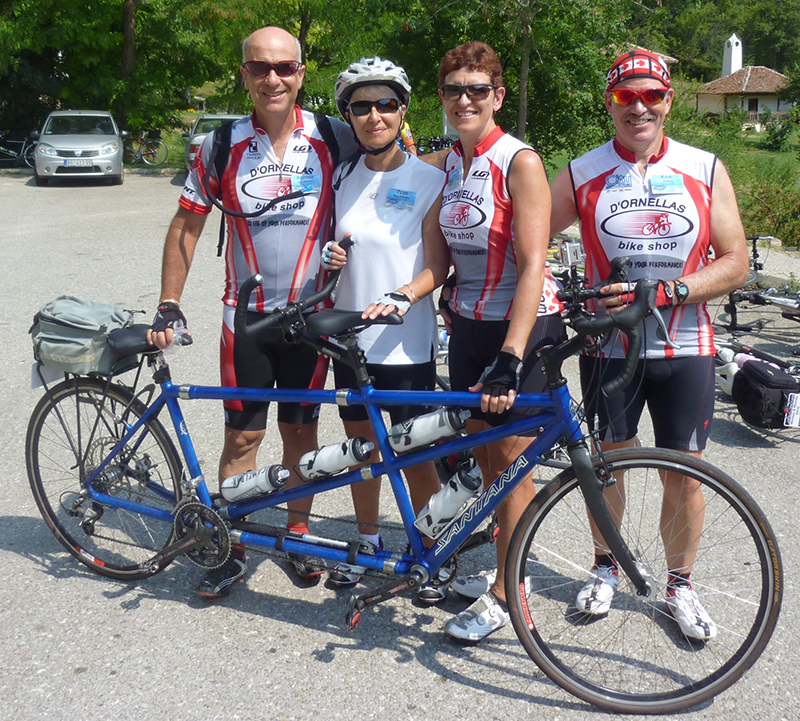
WHAT ABOUT AVID?
Santana has worked with the good folks at Avid for many years. Their powerful rim brakes are standard equipment on every tandem we sell. After Avid introduced an 8-inch disc brake, many tandem owners (and a few builders) attached this inexpensive single-bike component to their tandems. Because these brakes looked pretty cool, other builders ignored Avid’s published warnings against installing this brake on a tandem. Meanwhile, Santana had tested Avid’s mechanical disc against our tandem-specific brake protocol (published and disseminated since 1998), and immediately agreed with Avid that their brake was only adequate for singles. Specifically, in repeated real-world testing not one Avid brake survived a 500-foot descent on our short (.7 mile) and steep (15%) test course. Even when upgraded with a 10-inch rotor, Avid’s most powerful cable-operated disc faded into ineffectiveness after just over half a mile. Further—after a backup brake was used to rein-in the runaway tandem—we found that the Avid’s plastic pad-adjustment knobs and a non-replaceable internal nylon bushing had melted, which forestalled further use. While Santana continues to encourage our friends at Avid (now owned by SRAM) to produce a disc brake adequate for tandems, their “Ball Bearing” mechanical disc (an effective brake for single bikes) is not a safe choice for tandems.
WARNING – While many builders and dealers have installed Avid’s disc brake on a tandem, this use is not sanctioned or recommended by Avid, and voids the manufacturer’s waranty.WHAT ABOUT AVID?
Santana has worked with the good folks at Avid for many years. Their powerful rim brakes are standard equipment on every tandem we sell. After Avid introduced an 8-inch disc brake, many tandem owners (and a few builders) attached this inexpensive single-bike component to their tandems. Because these brakes looked pretty cool, other builders ignored Avid’s published warnings against installing this brake on a tandem. Meanwhile, Santana had tested Avid’s mechanical disc against our tandem-specific brake protocol (published and disseminated since 1998), and immediately agreed with Avid that their brake was only adequate for singles. Specifically, in repeated real-world testing not one Avid brake survived a 500-foot descent on our short (.7 mile) and steep (15%) test course. Even when upgraded with a 10-inch rotor, Avid’s most powerful cable-operated disc faded into ineffectiveness after just over half a mile. Further—after a backup brake was used to rein-in the runaway tandem—we found that the Avid’s plastic pad-adjustment knobs and a non-replaceable internal nylon bushing had melted, which forestalled further use. While Santana continues to encourage our friends at Avid (now owned by SRAM) to produce a disc brake adequate for tandems, their “Ball Bearing” mechanical disc (an effective brake for single bikes) is not a safe choice for tandems.
WARNING – While many builders and dealers have installed Avid’s disc brake on a tandem, this use is not sanctioned or recommended by Avid, and voids the manufacturer’s waranty.
